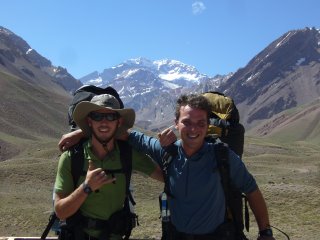 |
| Not long after entering the park, our first view of Aconcagua straight ahead. The highest mountain in Souther America. |
My first high altitude experience was when I was 20 years old alone and on December 14th 2004 as I reached the summit Pico de Orizaba, 5700m, which is the highest mountain in Mexico and the third highest in North America. Inspired by my very successful climb my eyes opened to even bigger objectives. Naturally, Cerro Aconcagua, which is the highest mountain in Argentina and actually the highest in the western hemisphere, caught my attention. At 6962m (22841 ft.), it catches the interests of mountaineers from around the world.
As I studied the mountain over the internet it evolved into a serious life goal of mine to reach its summit and I knew it would be my number one priority when I eventually travelled to South America. It was lucky then that I happened to come to South America with my best adventuring buddy: Sam Harrison. He was also enticed by the mountain and we were both eager and willing to have a crack at its soaring summit. We arrived in Mendoza, Argentina to buy our climbing permits on the last day before the 'early season' $110 US climbing permit would double up to 'mid-season' price. For another $100 US we purchased 11 days worth of food which would hopefully give us enough time to acclimatize while climbing over 4000m from the park entrance to the summit. We assumed that out previous acclimatization in the highlands of Bolivia would allow us to ascend much quicker than the average parties and thus we would spend less uncomfortable cold nights, have less time to run our spirits low, or be caught by objective hazards such as storms and rockfall.
We decided to do it in what we perceived as pure mountain ethics, which also meant doing it the cheapest way: with neither guides nor mules to carry our gear. Nearly everyone hires help to lighten their loads, but we would save $100 US each and feel extra satisfaction. After all, we would never hire a guide or mule service in Canada! Forced to carry all our own gear we brought the minimum of food and counted on a decreased appetite above 5000m. Still our bags were destructively heavy at about 30 kg (66 lbs) each for the 2 day 24km hike into base camp.
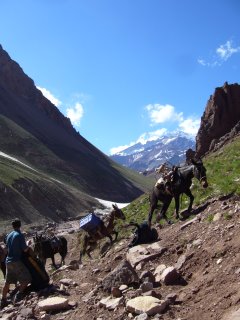 |
| Most climbers hired mules and guides but we were going it alone. |
From where the bus dropped us off it was a three km walk to the park entrance where we checked in and got our permits stamped. We soon arrived at a view point where Aconcagua was clearly seen and I must admit it looked foreboding. We were staring at its vertical south wall, which serves as a warning to all visitors: its cragged precipices beg all to turn around and walk away with your lives! Nearly one in every thousand climbers dies attempting the peak, and only 1 in eight ever make it to the top. The climbing season before us two people were killed after being swept off the wall by an avalanche while climbing the difficult south face. Their bodies were too difficult to remove and remain hanging there as a rather vivid warning sign.
But our route was much safer. For our route we had hard work ahead to traverse around to the north side of the mountain to where steep scree slopes and a trail ascend the summit. The severe mountain weather and altitude were the greater dangers for us.
As we approached camp one at 3300m a powerful mountain wind blasted dust and sand into our faces. It was very cold which worried us as to what was up ahead at higher elevations. The next day was an epic 18km trudge under heavy packs up to base camp at 4300m. During that we ascended a 1000m elevation gain, which under the strain of elevation, it took us almost ten hours. We only arrived in base camp as the sun disappeared behind the barren mountains walling in the valley.
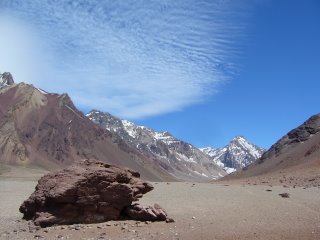 The whole day had been windy like hell. Now mushroom shaped lenticular clouds hung around all the major peaks indicating extreme alpine winds were being endured by parties at the higher camps. The temperature dropped off rapidly and we wasted no time getting deep inside our sleeping bags trying to keep warm.
The whole day had been windy like hell. Now mushroom shaped lenticular clouds hung around all the major peaks indicating extreme alpine winds were being endured by parties at the higher camps. The temperature dropped off rapidly and we wasted no time getting deep inside our sleeping bags trying to keep warm.Base camp was a small city with different tour company's tent camps, restaurant tents, and even an internet and phone tent. Coming from Canada where you are unlikely to have even one other party sharing the mountain with you, I had never seen anything like it. We took a rest day for acclimatizing and recovery and that night was even colder. That night the wind brutalized our tent bending the poles in on themselves with unrelenting force. The tent would have been destroyed if I had not stayed up all night holding the poles up with my own strength. That night the thermometer hit -14 C and with the 70-80km/hr winds it must have been -30 C or so with wind chill.
Many climbers were descending and not one had made the peak. All looked absolutely depleted. Weather conditions kept climbers stuck in their tents where they battled headaches and the cold for days on end. Hearing all this was very discouraging but we accepted that the weather can change and we retained optimistic that we are probably much tougher than the average person here. After all, it was clear that many people here were barely mountaineers, where as we had accomplished quite a lot and never with any assistance. To our advantage, we were in great shape, had good basic experience at high altitude, and were accustomed to climbing quite complex wilderness mountains in Canada. To our disadvantage, we had basic clothing, ie, leather boots, lighweight sleeping bags, and no down jackets.
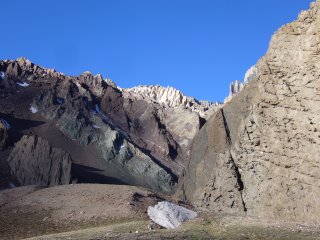
On day 4, we moved 680m up in elevation to our next camp at Plaza Canada ~5000m in elevation. We enjoyed this less populated camp and spent two days here to acclimatize and would have liked to spend a third. At 5000m you are roughly at the point where about half of the mass of the atmosphere is concentrated below you and thus there is considerably less Oxygen available. Here you could now feel the elevation strongly even when just sitting down and relaxing. We were forced to move slowly and methodically to avoid over-exertion and losing our breaths. To stay hydrated, we drank 4-5L of water a day. The camp was beautifully perched over the main valley while Aconcagua´s peak was still unseen nearly 2000m more above us.
Here we met two french canadians descending from high camp after they gave up. The elevation takes a toll on your health; your body simply cannot retain vitamins as well so the body slowly weakens even if it is gradually acclimatizing. And they were feeling depleted. They offered us there spare fuel and leftover food which we gladly accepted as it included among other delicacies: beef jerky, chicken jerky, fruit leathers, trail mix, Raisin Bran with milk powder. Wow! Much fancier than our instant noodles and pasta! This put us in a different situation, as we now had more time to acclimatize and we had way more food to feast on.
We considered spending another night at Plaza Canada to acclimatize until we heard that a weather forecast that a front was moving in off the Pacific and would bring colder weather as well as snow and wind. We had been really cold every night in our tent and the thought of nastier weather and colder winds seemed dangerous... besides we were feeling very well acclimatized with no headaches or signs of altitude sickness so we decided to move at the end of day 5, 500 m higher up to El Nido De Condores camp.
If we could do so safely, we preferred to summit sooner rather than later and then escape safely back to the colonial, tree-lined, beer-filled streets of Mendoza. Life was harsh on the mountain. Earlier that day we met two frazzled climbers at Camp Canada who had lost their spare tent, which was full of gear and critical supplies to the wind. The damn thing caught the wind like a parachute and was blown clear from the mountain, not to be seen anywhere.
In these harsh conditions, the only chance we had to stay warm was by meticulously utilizing all of our clothing, taking special time (sometimes over an hour) each night to cleverly layer and tuck layers under and over one another to maximize their heat retention. For an extra bit of warmth I slept in my leather boots and we emptied our backpacks and stuck our legs deep into the backpack. Getting up to go to the bathroom in the middle of the night was a daunting task and when drinking at least 4 litres of water a day to help acclimatizing it was unavoidable.
We were preparing ourselves for a summit attempt the next morning even though we had only 6 days of acclimatizing compared to most people who spend 10 to 20 days. Our plans were flexible and we were going to take a good day if we could get it. After all, we were still feeling relatively acclimatized. Unfortunately though, this also meant we were attempting to climb from only 5500m elevation, far below the higher camps that people usually leave from. A climbing day of 1450m from sea level is a tiring day but starting from 5500m it was going to be epic.
I awoke at 3 in the morning and fired up the stove to melt snow for water. We had planned to leave at 2AM as usual for such a climb but an experienced Aconcagua climber told us it was just to cold that early and we shouldn't leave before 5 or 6 AM. The air was terribly frigid at 3 AM as I worked the stove from inside my tent and sleeping bag and it took 1 1/2hours to prepare 6 litres of water. Our stove had been constantly faltering as dust was blown into it and blocking the fuel line. I had spent extra time the afternoon prior to clean the line, the jet, and the pump of any dust to ensure it would work smoothly on summit morning. We learned from our failed attempt of Jakouma in Bolivia that sufficient water was our only chance for the peak and proper acclimatization. We tucked the water bottles deep inside our already bulky jackets so they would not freeze to quickly. We drank an extra litre each to establish good hydration and headed out and away from the relative warmth and safety of our tents.
We were wearing absolutely every clothing item we had including balaclavas and multiply layered toques. We even brought our sleeping bags which we might need as extra insulation for the final 500m where the temperature was going to be severely cold. A nearly full moon led us up the first 400m into the eerie abyss of night. Snowlined mountain ridges cut the darkness far below us and the scale of this mountain started to sink in. We were trodding at a perfect little pace that kept us far from sweating or losing our breath. It was calm and surreal.
As we passed the first high camp, light struck the horizon and the world began to come alive around us. As the surrounding mountainous landscape was revealed it became apparent just how enormous Aconcagua is. With over 1000m to the peak left to climb, we already felt on top of the world and laughed at the puny 5000m mountain peaks that stood below us.
Now in the light of morning, we passed through the highest camp at 6100m where an old wind battered refuge housed nothing but the ghosts of climbers who had perished inside it... and one who was not dead yet but who was seemingly about to join the ranks. He was alive and standing with his pack reared and ready to go for summit. But his eyes were faint, his face was white, his voice was weak, and he was unable to engage in a conversation. He complained about having a roaring headache and exhibited a total lack of focus or balance, all of which are signs of high altitude cerebral edema, a condition that proves fatal if not treated by descent.
We had met this American climber at Camp Canada three days prior as he stumbled into Camp Canada exhibiting strong signs of Acute Mountain Sickness. Ourselves and others had urged him to descend to safety. But the fucker was possessed. He was a stubborn asshole, and determined to climb on. He had some notion that he was invincible because he had climbed Pico de Orizaba, ran marathons, etc.. He clearly had no respect for the dangers of this particular mountain, treating it as nothing more than another physical challenge. He had moved up to this high camp the day we had moved up to 5500m and to be honest I was surprised and glad to see him alive at all.
I begged of him to descend. Now. I grew frustrated and yelled at him; I was outright angry to see this because one who endangers himself only endangers one's rescuers. I did not want to risk my life to rescue him when the whole situation could be prevented. We left camp and continued on; he followed us close behind.
Ever so slowly but indeed constantly we trudged up switchbacks after switchbacks cut into the loose scree by the feet of climbers who had walked, experienced, and suffered here before us. The American climbers feet stumbled along not far behind ours. Our progress was going very well and at 6400m we were feeling minimal effects of altitude aside from feeling slow and a little breathless. We paused at an old hut long since destroyed where we met a German climber who was contemplating retreat. He had a headache and was realizing that there was still a very long way to go until the peak. We left him there to decide and just before we left his view I looked back to see the American climber conversing with him. As we would later learn the German climber had convinced the American to descend with him. There is no doubt that this German climber saved his life; I felt certain that he was going to die on this mountain and I was very disturbed to watch be a witness.
At this point, the trail left the sheltered ridge and began a long traverse across an exposed scree slope called the Canaleta. The wind roared at 80km/hr or so and the temperature plummeted. Half way across the slope we huddled behind a sheltering rock to execute our ingenious plan that was surely our only chance to make the summit.... While helping each other carefully remove our jackets, we unrolled then wrapped our sleeping bags around our body placing its hood over our heads, then carefully put our rain jacket back on to keep it in place. Wrapped in this extra insulation, we started up the frigid Canaleta, a disgusting 40 degree slope of loose, sliding scree that led to the summit ridge. Every two steps forward was mocked by sliding one step back. Progress was infuriatingly slow. Three deep breaths were necessary between each small step and we frequently paused for minute long breaks.
To keep my motivation up I accepted our pace for what it was: each step was another step higher than I had ever been before and that enough to keep me going. We picked our way up the slope tired and dizzy until around 6750m where we stopped to rest and converse. Here we sat down exhausted and both agreed it was more tiring than anything we had ever done before. We were drained and our heads began to feel very dizzy and lightheaded. "What do you think man?" Sam Asked me. "I think that I have to go for it," I replied. It seemed that going higher would perhaps be dangerous but neither of us actually had symptoms demanding us to retreat so we resolved to keep on going.
Finnaly, we reached the ridge and on the other side a vast new world was below us. Even though it was probably one of the most sensational views in the world I had little capacity to enjoy it. I hardly glanced at it but rather kept on going; now we could see the peak before us and we knew we were going to make it. A German climber who we met the other day was coming down and gave us words of motivation, such as "your through the worst" and then he told us something I never will forget: "only about one more hour to go...." I didn't understand. I looked up and the peak was right infront of us, maybe 5 or 10 minutes away! I wondered if he was delirious? But then self-realization sank in, and I realized how incredibly slow we were moving. Indeed, one hour to go. As we slogged on my balance began to feel way off and my head began to spin. My energy had dropped so low, that I considered laying down and letting go... With only 30 meters left to the peak another step higher would be poison... but I knew that I had to continue.
We were now high in the sky, and I do mean both literally and in a figurative sense, and almost on top of the Americas. We scrambled up and over rocks until a plateau with a small cross was before us. A little rock ledge was one of the final steps to the peak. Sam led up it and then stumbled a step backwards just catching himself on his feet. Not a word was exchanged; no "whooah, be careful buddy." We just paused for a few breaths and then another attempt. Our worlds had become very dull and passive, our steps small and weak, nothing felt expected nor adequate; it was just the way it was, all we needed to do was more one foot in front of the other and that was all that mattered.
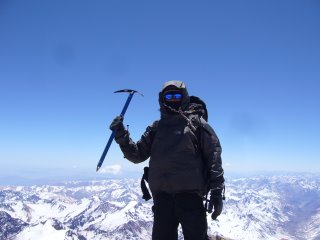 |
| Myself standing on the summit 6962m |
As we slowly descended my head felt better and better and the reality sank in about what we had accomplished. We had an absurdly direct route back to camp straight down a 1250 meter scree slope. It still took us many hours and after every couple hundred meters of descent we would collapse and rest for a few minutes. We made it back down to camp feeling annihilated as if we had been physically beaten up by a gang of thugs. Our energy was very low and our heads felt soar and dull. We made some food and melted some water but were unable to consume much of either. We had wanted to descend down to base camp but we were to exhausted to consider it so we slept another freezing night at 5500m.
I slept deeply for 12 hours and then we woke up and immediately dismantled camp and descended to base camp. There I felt that it was done. We did it and were now back to relative safety and away from the grip of cold discomfort. After seeing such a terrible failure rate it felt all the better that we succeeded. On our perfect summit day alone only 7 of 18 people made the peak.
I was very happy to see some familiar faces of people we had met at high camps and they were very happy we had made it. And then the weirdest thing happened. Along came the American climber we had seen marching to his death and as he approached I smiled at him and said "hows it going buddy?" He looked at me the way a perfect stranger would in a busy downtown center confused as to if he is supposed to know you. It took him a minute to think and finally he remembered me as the guy he saw somewhere up on the mountain. We had met him at several different locations and engaged in serious conversations each time. That is no doubt a testament to how badly the elevation was affecting him. I only shared a piece of what i would have liked to say to him because he was still visibly in discomfort from the altitude and as he walked off he said something like, "no big deal, there is lots of mountains out there, next year I think I'm going to Mt. Everest."
We decided to leave base camp and began the 24 km hike out to the highway with now much lighter packs with less food and fuel. After over 8 hours of continuos hiking and 2800m of descent we left the park entrance and went straight for the restaurant on the highway. We decided to catch a bus at 9PM back to Mendoza and arrived in the bus terminal at 2AM. We wanted beer, steak, pizza, showers and beds. Back at our hostel we got all this. It was a thursday night and all the restaurants were packed at 3AM so we joined the scene for Pizza and beer. A litre of beer and a delicious pizza on a crowded sidewalk cafe surrounded by beautiful girls and good music for only 6 dollars reminded me how much I love Argentina.
Coming out of a hike successfully and sitting down for a warm meal and a beer is perhaps the greatest feeling in the world. With Aconcagua behind us the entire South America trip seemed totally successful, and anything more was just another feather to add to the cap. After a few days relaxing and feasting we headed right back into the mountains only this time in Patagonia with lots of wine, great steak, and a rental car. We wished to climb a famous volcano called Lunin but I think our main goal was to camp, fish and hike - generally, to simply enjoy being alive.
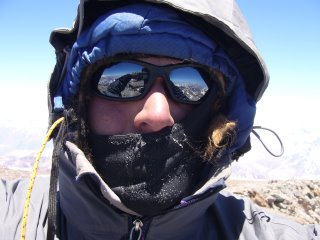
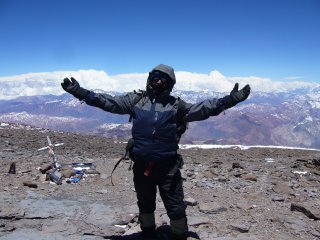 |
| Climbing partner Sam Harrison on the summit |
1 comment:
MAAAAATE, that is just brilliant. I climb a steep set of stairs and i'm stoked, you must be in awe at your achievement of climbing such a mountain. Great read!!! Glen Steggles.
Post a Comment